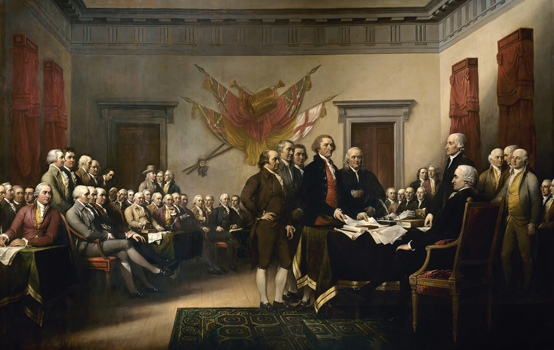Protecting public education requires us to return to the ideals on which our country was founded.
Public education as we know it is in trouble and, with it, so is our democracy. Rather than seeing it as a solution to segregation, inequality, and division, many now claim that the idea of public schooling itself is the problem. “Government schools,” as some pejoratively call them, deny families freedom and ought to be abandoned for the private market.
Fully appreciating the danger of this rhetoric and the policies it is producing requires us to look backward, and beyond schools themselves to the history of the nation’s major democratic and constitutional developments. The nation, in its infancy, built its concept of democracy around public education, and, following the Civil War, public education — alongside the right to vote — became the cornerstone of the recovery of the war-torn nation. For that reason, those who would overthrow democracy have sought to attack public education, particularly during Jim Crow segregation. The lessons found in this history, more than the heated rhetoric of the present day, should inform our current approach to strengthening our schools.
Founding gifts
Two hundred years ago, our founding fathers gave us two gifts, both of which were relatively unknown to the world at the time. The first was democracy — what they called a republican form of government. The second was public education. These gifts were inextricably intertwined.
A republican form of government would allow everyday people to govern themselves through elected representatives. Our founders knew what it was like to live under a king, and they wanted something radically different for themselves, their families, and the generations that would follow. Of course, by denying African Americans, women, and many poor whites the right to vote, the founders failed to live up to their lofty ideals. But those ideals, though flawed in their initial implementation, were compelling enough to take root and bear fruit for generations to come.
The nation, in its infancy, built its concept of democracy around public education.
The contradiction between our democratic ideas and the practical reality was also strong enough to spark a civil war and, after it ended, a constitutional change. The post-war Constitution prohibited racial voting restrictions, and in subsequent decades, gender and wealth restrictions were eliminated. A century later, the passing of the Voting Rights Act showed the nation once again marching further toward its founding ideas, not away from them.
The story of public education goes hand in hand with that of democracy and voting. That story, however, is not as well told. In fact, some of the very best parts of the story have been lost to memory and never fully pieced together as part of the nation’s democratic expansion. In my own research (Black, 2020), I’ve mined that history to help us better see who we are and have been — for better or worse. The lessons and values in that history also serve as an objective measuring stick for education today, something sorely missing from most conversations about our public schools.
Sadly, when it comes to our schools, the last decade aligns better with the darker periods of our history than the brighter ones. States have drastically cut public education budgets, made the teaching profession increasingly inhospitable, and refused to take seriously increasing segregation and inequality. The states’ solution — incentivizing charters and vouchers — is no solution at all. It has made matters worse. These trends are alarming not just for public education. They are alarming for democracy itself. But recent history also suggests that the power of the idea of public education remains strong enough to persevere. In fact, public education may be the one institution that can help bind this nation’s wounds, just as it has in the past, and move us once again closer to our democratic aspirations.
Education and democracy: Linked from the start
From its first days, the nation’s theory of government depended on educated citizens. The founders feared that, without an educated citizenry, democracy would devolve into mob rule, open doors to unscrupulous politicians, and encourage hucksters to take advantage of citizens even as they stood in line to vote. They knew that our democracy might very well just fail. When asked at the close of our Constitutional Convention in 1787 what sort of government the founding fathers had created, Benjamin Franklin reportedly said, “A republic, if you can keep it.”
While our understanding of our nation’s commitment to democracy primarily comes from the Constitution, the nation’s commitment to public education predates the Constitution. In 1785, two years before the Constitutional Convention met, the Continental Congress, which attended to immediate concerns, faced the pressing question of how to incorporate the western territories — land that would later become the states of Ohio, Illinois, Indiana, Michigan, Wisconsin, and Minnesota — into our new nation. The answer came in the form of one the most important sets of legislation ever passed, the Northwest Ordinances, which defined the rules for how the nation would divide new lands into territories and towns that would ultimately become states. Those same rules also governed the land west of the Mississippi that the United States later acquired. In total, the Northwest Ordinances shaped what would become 31 states.
Education was embedded into the very structure of these new lands. The Northwest Ordinance of 1785 required that every town be divided into 31 lots. Four of those lots and one-third of each township’s natural resources would be used to generate resources for public education, and the 16th lot in every township would be the site of a public school. Two years later, while delegates to the Constitutional Convention were meeting in Philadelphia, the Continental Congress passed the Northwest Ordinance of 1787, which moved beyond the mundane particulars of dividing up lots to authoritatively announce the guiding principles by which our political community would govern itself and grow. It provided that “religion, morality, and knowledge, being necessary to good government and the happiness of mankind, schools and the means of education shall forever be encouraged.”
Universal access to public education — much like the opportunity for everyone to participate in self-government — was a concept honored more as an ideal than as reality for much of the nation’s first century.
Once the Constitution was in place, our first presidents implored the nation to expand public education as rapidly as possible. In a formal letter to Congress, President George Washington wrote that no “duty [is] more pressing on [the national] legislature” than “the common education of a portion of our youth from every quarter” because the youth are “the future guardians of the liberties of the country” and, thus, the very “prospect of [a] permanent union” depends on their education (Washington, 1796). John Adams (1851) argued that, as a matter of democratic theory, government had a responsibility to provide education to “every rank and class of people, down to the lowest and the poorest” and pay for it at “public expense.” He envisioned something so grand “that [it] never yet has been practised in any age or nation” (p. 168). Thomas Jefferson was similarly convinced that public education is “necessary to prepare citizens to participate effectively and intelligently in our open political system [and] to preserve freedom and independence” (as summarized in Wisconsin v. Yoder, 1971). As president, he boldly proposed committing the nation’s financial treasure and future surpluses to education and urged Congress to amend the Constitution to allow for education’s support, if necessary.
With these leaders and ideas pushing education forward, the country made enormous strides in the creation of schools, distinguishing itself internationally. By the early 1800s, the only country in the world with greater educational access was Prussia, which had a century-long head start on the U.S. (Go & Lindert, 2010, p. 3). Yet universal access to public education — much like the opportunity for everyone to participate in self-government — was a concept honored more as an ideal than as reality for much of the nation’s first century. The most glaring breach of the country’s commitment to education was slavery. Not only did the nation bind slaves’ bodies, it tried to bind their minds, making it a crime for slaves to read and write.
That breach brought forth some of the nation’s most inspiring and redeeming moments — moments that the modern mind struggles to fathom. Shortly after the Civil War began, slaves fled for Union lines, and once they reached safety, education was foremost on their minds. Makeshift schools quickly swelled beyond anyone’s expectation in places like Fort Monroe, Virginia, and Port Royal, South Carolina. Underneath it all was a preternatural longing and belief among the enslaved that learning would reach them somehow. When a white missionary first arrived at a freedmen’s camp along the Mississippi River and announced that she had come to teach, an elderly man, newly freed, who greeted her at the water’s edge immediately responded that he already knew her purpose and that “I’se been ’spectin you . . . for de last twenty years. I knowed you would come, and now I rejoice” (Yeatman, 1864, p. 2).
When teaching actually began in these newly secured locations, it was a sight to behold. In the Freedmen’s Camp in Vidalia, Louisiana, an observer told of a thousand of the formerly enslaved gathering under a large magnolia tree to learn from a missionary teacher. In other camps, they met anywhere they could, for as long as they could, even deep into the night. An official report to Congress later rhetorically asked: “What other people on earth have ever shown, while in their ignorance, such a passion for education?” (Alvord, 1868, p. 10; U.S. House of Representatives, 1872, p. 280).
With swelling numbers and passion came strength. The chorus of freedmen asking for and sometimes demanding education reached a fever pitch in the subsequent years. Their expectations for their new lives, and articulation of what freedom would mean for them, redefined the nation’s constitutional norms regarding citizenship. Education and voting were at the top of their list of demands — and it soon became Congress’ business to respond. As a condition for rejoining the Union after the war, Congress forced Southern states to rewrite their constitutions to include the right to education. Northern states soon followed suit. A constitutional guarantee of education became the new norm among states: No state would ever again enter the Union without guaranteeing education in its constitution.
Today, all 50 state constitutions protect the right to education. They also attempt to insulate public education from partisan politics. In Pennsylvania, one state constitutional convention delegate proclaimed in the late 1800s that “there are no political considerations connected with [education] in any part of the Commonwealth” (“Debates,” 1873, p. 387). To ensure that this would be the case, the constitution would include a state superintendent for education and make it a position free “from all the contaminating influences of political manipulation and management” to be filled by, as another delegate explained, someone “characterized by official purity.”
Rights at risk
Over the past half century, our voting and educational systems have continued to suffer imperfections, but the idea that individuals have a right to vote and receive an education were no longer in serious dispute. The American experiment had succeeded in convincing the overwhelming majority of people that everyone — save maybe felons — ought to be able to vote and that the federal and state governments are responsible for providing a quality education to all.
But democracy’s triumphs are not irreversible. Today, an increasing number of states — aided and sometimes prodded by top federal officials — are trying to take back the gift of public education, sometimes quite obviously through private school vouchers and tax credits and other times less obviously through a system of charter schools that hands over public responsibility and accountability for education to private industry. It should come as no surprise that this privatization is happening at the same time that some are restricting access to the ballot box. While threats to the ballot are immediately understood as threats to democracy, attacks on public education are not always fully appreciated as such. But rest assured, the gift of public education is just as essential to democracy as the vote.
In the spring of 2018, tens of thousands of teachers, parents, and students across the nation marched together in states like West Virginia, Kentucky, Oklahoma, Arizona, and North Carolina, demanding that their state legislatures repair the financial damage that had been done in the previous decade and cease any moves toward limitless privatization. They won key legislative victories at the state level, including, for instance, the defeat of a statewide referendum to expand vouchers in Arizona and a commitment to increase teacher benefits in West Virginia. In fact, data revealed that school funding went up significantly in these protest states as compared to others (Leachman & Figueroa, 2019). This protest and advocacy movement was sufficiently forceful that it caught the full attention of the Democratic party’s slate of presidential candidates, who spent a full day late in 2019 laying out their education plans. In his presidential acceptance speech on November 7, 2020, Joe Biden explicitly acknowledged this background, saying “For American educators, this is a great day for you all.”
The worldwide COVID-19 pandemic, however, reset major parts of the political and cultural landscape. Without having even repaired the damage done from the last recession, states are cutting public education again. The technology gap is more evident and consequential than ever before, expanding an already unacceptable achievement gap separating low-income students from their more affluent peers. At the same time, parents with means started retreating to their own corners, worried less about the overall health of the education system and far more about ensuring their own kids remained on their upward trajectory. The result was a new wave of private school enrollments and pandemic pods. While the precise numbers of that shift are unclear, public school enrollments have dropped significantly — down 85,000 students in Tennessee, for instance. National and state leaders eventually began charging that public education itself is the problem and the refusal to physically reopen all schools was holding the national economy back. All of this, of course, occurred in the midst of one of the most divisive presidential elections of the modern era, the effects of which persist.
Public education has always served to bring disparate groups together and expand opportunity to those who’ve been denied it. Private schools, quite frankly, have never had the capacity or desire to serve all students. Our ability to reach the other side of the current national crisis as a stronger nation rests not upon radical new ideas that denigrate or undermine public education but upon our willingness to cling to those ideas that were once radical, 200 years ago, and that managed to get us this far.
References
Adams, J. (1851). The works of John Adams, Vol. VI, Defence of the Constitutions (C.F. Adams, Ed.) Boston, MA: Little, Brown and Co.
Alvord, J.W. (1868). First semi-annual report on schools and finances of freedmen: January 1, 1866 Washington, DC: Government Printing Office.
Black, D. (2020). Schoolhouse burning: Public education and the assault on American democracy. New York, NY: Public Affairs
Debates of the convention to amend the Constitution of Pennsylvania, Vol. II (1873). Harrisburg, PA: B. Singerly.
Go, S. & Lindert, P. (2010, March). The uneven rise of American public schools to 1850. Journal of Economic History, 70 (1), 1-26.
Leachman, M. & Figueroa, E. (2019, March 6). K-12 school funding up in most 2018 teacher-protest states, but still well below a decade ago. Washington, DC: Center on Budget and Policy Priorities.
U.S. House of Representatives. (1872). Report on the condition of affairs in the late insurrectionary states. Washington, DC: Government Printing Office.
Washington, G. (1796, December 7). Eighth annual message. In The Avalon project: Documents in law, history, and diplomacy. New Haven, CT: Yale Law School., Lillian Goldman Law Library.
Wisconsin v. Yoder, 406 U.S. 205, 221 (1971).
Yeatman, J.E. (1864). A report on the condition of the freedmen of the Mississippi. St. Louis, MO: Western Sanitary Commission.
ABOUT THE AUTHOR

Derek W. Black
DEREK W. BLACK is a professor of law and the Ernest F. Hollings Chair in Constitutional Law at University of South Carolina, Columbia. He is the author of Schoolhouse Burning: Public Education and the Assault on American Democracy .










